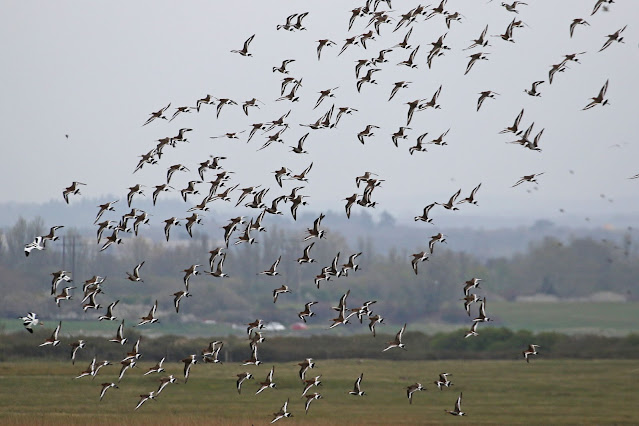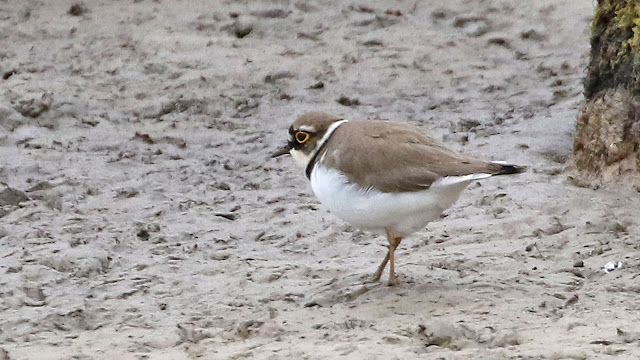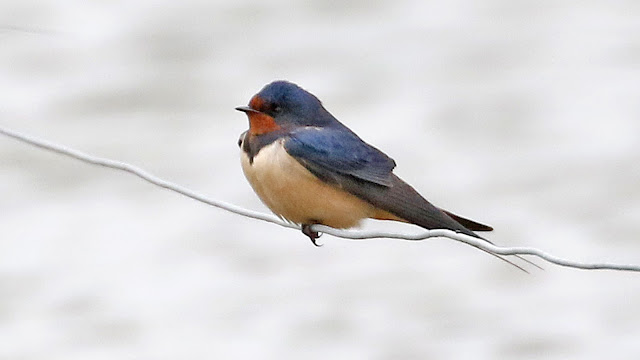On a cold overcast morning and with a weather forecast that was nothing less than awful I arrived at the car park on the esplanade at Southsea castle. This visit is usually one that we do earlier in the year but for various reasons we had put it off until now. Reports suggested that the target birds were still about so we were hopeful as we walked from the car park to the esplanade. The tide was out and pretty much all of the sea wall surrounding the castle was exposed, still wet with the treacherous green and brown sea weed and bladder wrack. Overhead Mediterranean Gulls could be heard calling as they moved along the beach.
A quick scan of the rocks and sea wall showed that we were not going to be disappointed, about a dozen Purple Sandpipers were either asleep on the rocks or feeding in amongst the sea weed and water.
This has become the dead cert site for Purple Sandpipers with the numbers slowly increasing every year, this year there have been over twenty counted, quite remarkable for such a busy location. The best time to see then is just before high tide as they are pushed up the rocks and wall by the rising water. This morning the tide was the lowest I have encountered on one of these pilgrimages and the sandpipers were taking the opportunity to roost.
Like their cousins the Sanderling, the best tactic with them is to get as close as you can then find a suitable spot to sit and just wait, the birds will do the rest.
Like the Sanderling they are very active feeders and move very quickly from the advancing waves. I try to get the shots that portrays this behaviour and there is nothing better than a breaking wave to demonstrate this
It is also nice to get an angle that shows them a little differently like here as the head appears from behind a rock.
When feeding the head and bill is probing all the time, the head moving like a small jack hammer as it moves the weed and pushes into the little pools of water in search of anything it can eat.
But it really is the crashing waves that demonstrate the habitat that these little waders live and exploit in, most of the time they manage to avoid a good soaking, but every so often the sea catches them out.
The purple sandpiper is slightly larger and stockier than a
dunlin, giving it a distinctive "dumpy" shape. In winter they have a
brown-grey head and back, with whitish underparts that have dark streaks -
giving them a less clean look than the similar dunlin. The short legs are
orange-yellow, and the down-curved bill has a yellowish base.
We make this trip once a year to secure the year tick, if we come across them anywhere else then that is a bonus. When we meet up with them, like the Sanderling they are extremely photogenic as you are able to get close to them and record their distinctive behaviour, so no apologies for the quantity of photographs, I consider the to be quality.
Our needs satisfied we bid these enigmatic waders farewell and advised them we would be back next year. I am sure they will be on their way north in the next few days, so our visit was timely.
Our next stop on the day would be at Eastney, a short trip along the beach. Here we were hoping for the Little Owls in Fort Cumberland, but to be truthful our expectations were not high. The overcast and cold conditions were not conducive and as we arrived the security guard was playing with three dogs in front of the fort.Needless to say there were no Little Owl on show, as we walked back to the cars Ian noticed a Mediterranean Gull flying along the beach and it was watching the tide line, not something you often see with Mediterranean Gulls.
I like to refer to the Mediterranean Gull as a "snowball", an adult in breeding plumage is a wonderful sight and this individual put on a wonderful display as it flew up and down the beach, occasionally dropping into the water.
As it dropped to pick something out of the water we noticed that it had no webbed foot, we could only see one so we could not be certain what the condition of the other was in. It didn't seem to hamper the bird and it was with another we had to assume was it's mate.
Back at the cars we were deciding where to go next when Ian reminded me of the Little Gull that had been at Budds Farm. A quick check on the map and we were on our way. After a false start we found the car park and were able to get a free place, then it was a walk around the sea wall to the west. The wall circles what must have been an old tip. A path up the side of a fence opened up to a view across a series of gravel pits and the sewerage farm in the distance. The pits were covered in gulls, mostly Black-headed Gulls, but with Mediterranean Gulls overhead and cruising Lesser and Great Black-backed Gulls. The air though was full of the calls of Black-headed.
An opening allowed views across the pits and we searched through the many gulls. Ian then found the Little Gull, its flight behaviour so distinctive from the other gulls and as it banked the distinctive black under wing showed well. We walked back to our original spot where we could see the pit that the gull seemed to prefer and I managed to get some clear views.
It flew around constantly dipping and swerving constantly, the black underwing so distinctive.
The challenge was to get closer and with a clear view and we managed to scramble down the side of the hill. Rubbish and rubble was partially covered by bramble and nettles, but we were able to get to the fence surrounding the pits and this put us in the position to get some great views as the Little Gull flew around.
It was actively feeding, the flight hesitant and wavering as it dips down the legs trailing to pick up small organisms on the surface of the water.
The main breeding areas of the Little Gull are in east and west Siberia with local colonies in the Baltics and parts of the Netherlands, Sweden and Denmark, wintering to the south to north west Africa with migrants seen along the coasts April to May and August to October, however winter storms can bring them in at any time.
Now to aging, it has been reported as a send calendar year bird. This would mean it is coming into its first summer plumage. Both Collins and and Seabirds state that would have clear underparts and the saddle seen in first winter birds. The Little gull is seen as having three age groups, a second summer bird would have the partial hood and dark under wing, however it would have sub terminal black marks on the 2 - 6 primaries. In these photographs the primaries are white.
So is this an adult going in breeding plumage with the hood only partially developed as yet? I am no expert on Gull aging, and would welcome any comments, but reading the reference books to me this is an adult bird.
That aside it was wonderful to watch as it flew around the pits, the contrast between the pale grey upper parts and the striking black underparts so evident.
As well as the gulls flying around the pits there were Swallows and a few House Martins. Scrambling up the bank we left the gull and went to try and find a singing Willow Warbler. The Willow Warbler gave us the run around, but a couple of Blackcap singing showed very well. First in an Elderberry tree.
Then singing amongst the Blackthorn blossom.
After taking an early lunch on the sea wall with the tide rising we decided that the next stop would be Farlington Marshes, it was close and at this time of year you just never know what could turn up.
Walking along the sea wall yet another confiding a showy Cetti's Warbler appeared in the bushes after singing.
And if you ever wondered what they look like when the explode in song, here it is
With the tide high there was a sizeable wader roost on the lake. The duck numbers though were very low compared with my last visit. Two Greenshank fed at the back of the lake and there were twelve Avocet in amongst a good number of Black-tailed Godwits and Redshank. Suddenly everything went up, the Godwits always looking smart in flight and at this time of year there is the bonus of the russet red plumage.
It then became clear the reason for the panic, a Red Kite was drifting over the reed bed, although not a threat to the waders or duck, there was the immediate panic of a raptor close. The Shelduck were probably the most concerned and several of them put up a determined attack on the kite forcing it away to the east. This was the first time I had seen a Red Kite here at Farlington
The Avocet are always worth a photograph in flight.
Laving the Lake we scanned the fields and bushes for migrants but it was quiet, nothing of interest about. Turning the corner there is a pool close to the sea wall and feeding along the edge were two Little Ringed Plover.
Much better views than we have had so far this spring.
Unfortunately as we tried to get a little closer and down from the sea wall they flew off and away across the lake.
The weather was changing, it now felt much colder the wind now clearly north easterly rather than from the west, not the ideal conditions for finding migrants. We stopped to talk to a couple who advised us that there were plenty of "pine martins" flying over the stream by the visitor centre. Not wanting to embarrass him I said nothing, but the bemusement between Ian and I gave it away and he quickly realised his mistake. A shame really I would have enjoyed watching that spectacle.
The walk through Point Field didn't produce anything of interest other than a single Sand Martin that circled the bramble bushes. At the Deeps there were plenty of Black-headed Gulls calling and Mediterranean Gulls yelps could be heard above us. Out on the marsh there were a few Wigeon, we found five Brent Geese and a pair of Shoveler. The most numerous duck was Shelduck, I counted 121 but I felt that there was probably more.
A single Mediterranean Gull stood out on the marsh by being on its own. But it was soon joined by a Black-headed Gull
There was then some displaying taking place indicating that maybe they were a couple, they definitely looked happy together.
Something to consider when that strange looking gull appears in the autumn.
Walking from the sea wall to the visitor hut a smart Song Thrush was hunting on the marsh alongside the path.
At the stream there were definitely hirundines, mostly swallows there were also a few Sand Martins amongst them.
Although we said we wouldn't we couldn't resist the challenge of the swallows.
In the air above us was OK but the greater challenges was as they flew low over the water straight at us, exposure, shutter speed and just being at the right place at the right time was a huge challenge, and we probably took hundreds of blurred images to get these
It was a lot easier when they settled on the posts in the water or the wires of the fences.
While this was going on Black-tailed Godwits and a couple of Avocet fed in the water close by. At one point they all went up, we couldn't find the reason but it allowed me the opportunity to get the Avocet in flight and to convert to black and white.
The other distraction from the swallows were the pings of Bearded Tits coming from the reeds to our left. Eventually we couldn't resist and found two pairs in the reeds, of course the focus was on the males.
But as they melted back into the reeds we turned back to the Swallows, this one on the barbed wire fence.
And above the reeds.
Finally we managed to drag ourselves away and walked across the field to the sea wall at the lake. As we climbed up the bank the tide was now well out. It was still high when we started photographing the swallows, how time flies. We walked back to see if the Little Ringed Plover had returned to the pool. They were not there, but there was a very smart Black-tailed Godwit.
However like the Mediterranean Gull at Eastney it had a very damaged leg, but this did not seem to impair its ability to feed or behave as others.
With that we decided to call it a day, a day that I had very low expectations for in regard to weather and birds had really delivered, there had not been any rain, and we had some great experiences, not least the Little Gull, a bird I have not seen for a while.






































































































No comments:
Post a Comment